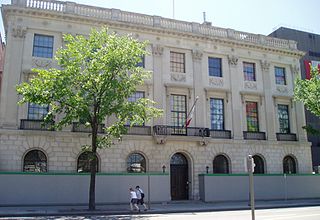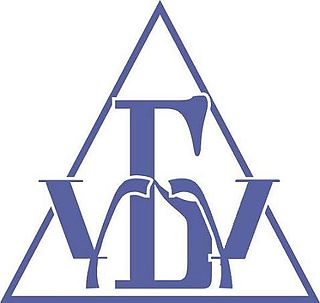
An auction is usually a process of buying and selling goods or services by offering them up for bids, taking bids, and then selling the item to the highest bidder or buying the item from the lowest bidder. Some exceptions to this definition exist and are described in the section about different types. The branch of economic theory dealing with auction types and participants' behavior in auctions is called auction theory.

Financial services are economic services tied to finance provided by financial institutions. Financial services encompass a broad range of service sector activities, especially as concerns financial management and consumer finance.
The Canada Revenue Agency is the revenue service of the Canadian federal government, and most provincial and territorial governments. The CRA collects taxes, administers tax law and policy, and delivers benefit programs and tax credits. Legislation administered by the CRA includes the Income Tax Act, parts of the Excise Tax Act, and parts of laws relating to the Canada Pension Plan, employment insurance (EI), tariffs and duties. The agency also oversees the registration of charities in Canada, and enforces much of the country's tax laws.
The minister of public services and procurement is the minister of the Crown in the Canadian Cabinet who is responsible for overseeing the Government of Canada's "common service organization", an expansive department responsible for the internal servicing and administration of the federal government. A flavour for the department is given by the list of acts and regulations for which it is responsible.

Public Services and Procurement Canada, formerly Public Works and Government Services Canada, is the department of the Government of Canada with responsibility for the government's internal servicing and administration.

The Portrait Gallery of Canada is a federally-registered not-for-profit corporation that currently has no collection or physical presence.
Canada Lands Company Limited is a self-financing federal Crown corporation reporting to the Parliament of Canada through Public Services and Procurement Canada. The company is responsible for managing property on behalf of the federal government, conducting public consultation and integrating properties back into their surrounding communities for development. Most of its assets are located in Canadian urban centres, and are sold after the CLC revalued the property by providing managerial support and subsidizing immediate costs such as decontamination. However, the company retains ownership of some of Canada's most valued properties, such as Downsview Park, the CN Tower, the Old Port of Montreal and the Montreal Science Centre, from which it draws rental and hospitality revenues.
The Indian Railway Stores Service (IRSS) is one of the Group A central engineering services of the Government of India. The officers of this service are procurement and logistics specialists, contract managers on the Indian Railways, providers of logistics for the transportation of material from and within various railways as well as the planners and maintainers of the intelligent warehousing with automated storage and retrieval systems on the Indian Railways. The IRSS officers undergo training at National Academy of Indian Railways (NAIR) for a period of 18 months which includes two months certification course at IIM Khozikhode and a foreign training.

The National Helium Reserve, also known as the Federal Helium Reserve, is a strategic reserve of the United States, which once held over 1 billion cubic meters of helium gas. The helium is stored at the Cliffside Storage Facility about 12 miles (19 km) northwest of Amarillo, Texas, in a natural geologic gas storage formation, the Bush Dome reservoir. The reserve was established with the enactment of the Helium Act of 1925. The strategic supply provisioned the noble gas for airships, and in the 1950s became an important source of coolant during the Cold War and Space Race.
The War Assets Administration (WAA) was created to dispose of United States government-owned surplus material and property from World War II. The WAA was established in the Office for Emergency Management, effective March 25, 1946, by Executive Order 9689, January 31, 1946. It was headed by Robert McGowan Littlejohn.
Crown corporations are government organizations in Canada with a mixture of commercial and public-policy objectives. They are directly and wholly owned by the Crown.

The Canadian Commercial Corporation is a Canadian federal Crown corporation mandated to support the growth of international trade by helping Canadian exporters gain access to foreign government procurement markets and by helping government buyers abroad to obtain goods from Canada. The ability to enter into commercial contracts as a Government of Canada entity through CCC is designed to give Canadian exporters the opportunity to mitigate risks associated with foreign procurement and international contracting. Canadian businesses exported $2.92 billion in products and services through CCC contracts during the CCC’s 2020-2021 fiscal year.

Section 125 of the Constitution Act, 1867 is a provision of the Constitution of Canada relating to taxation immunities of the federal and provincial governments. The section provides that the property of the provincial and federal governments are not subject to taxation.

A government auction or a public auction is an auction held on behalf of a government in which the property to be auctioned is either property owned by the government or property which is sold under the authority of a court of law or a government agency with similar authority.

Ukrainian Universal Exchange (UUE) — Ukrainian company, commodity exchange, which is represented in several regions of Ukraine. June 2015 - the largest exchange in Ukraine.

Liquidity Services (NASDAQ:LQDT) operates a network of e-commerce marketplaces.
The Phoenix pay system is a payroll processing system for Canadian federal government employees, provided by IBM in June 2011 using PeopleSoft software, and run by Public Services and Procurement Canada. The Public Service Pay Centre is located in Miramichi, New Brunswick. It was first introduced in 2009 as part of Prime Minister Stephen Harper's Transformation of Pay Administration Initiative, intended to replace Canada's 40-year old system with a new, cost-saving "automated, off-the-shelf commercial system."

In Canada, a deferred prosecution agreement (DPA) or remediation agreement refers to an agreement under Part XXII.1 of the Criminal Code. The agreement is made between the Crown prosecutor and an organization alleged to have committed certain types of criminal offences, usually in the context of fraud or corruption, with the consent of the relevant Attorney General and under the supervision of a judge. Under a deferred prosecution agreement, the Crown prosecutor can agree to defer bringing a prosecution for the alleged offences if the organization takes steps to improve its conduct, makes restitution, and implements internal controls to avoid a repetition of the conduct.

The Accessible Canada Act is a Canada-wide accessibility act that applies to the federal public sector, Crown corporations, and all federally-regulated organizations, building on the Canadian Human Rights Act and focuses on the prohibition of discrimination based on disability.

The Financial Administration Act is legislation enacted by the Parliament of Canada, governing financial administration of the government, public assets, the estimates process, the Department of Finance, the Treasury Board of Canada and Crown Corporations. The Government of Canada has described the act as the "cornerstone of the legal framework for general financial management and accountability of public service organizations and Crown corporations."









